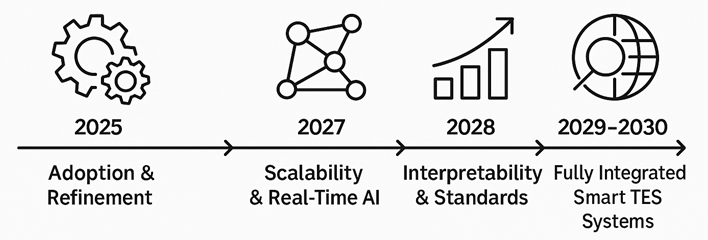

Artificial intelligence is transforming the way we predict and manage thermal energy storage (TES). Deep learning models, such as LSTM, have significantly improved accuracy in forecasts, sometimes by over 20%, particularly when dealing with systems in complex and dynamic conditions. An accurate prediction of TES operational performance allows better energy utilization, enhances efficiency, reduces operating costs, and aids the integration of renewable energy sources. These models, such as Support Vector Machines (SVM) and Long Short-Term Memory networks (LSTM), are excellent in dealing with the nonlinear, time-dependent nature of thermal systems. Artificial Intelligence (AI) is now setting a new standard for state-of-the-art development in predictive intelligence, with innovative approaches including hybrid architectures and attention-based models, providing highly adaptive and real-time solutions for energy system optimization.

Figure 1: Evolution of Thermal Energy Storage (TES) Systems From Traditional to Advanced AI-Integrated Systems.
LSTM models are variants of Recurrent Neural Networks (RNN) that are especially good at handling time-series data, thereby best suited to predict thermal-related phenomena that are in motion for a specific duration, with instances including energy storage, and time change of charging and discharging behavior. In other words, LSTMs are equally good at absorbing long-term dependencies present in the data because of their specialized architecture. In a nutshell, it means that they can learn how early-stage conditions (starting temperature or flow rate in TES) affect the later stages in the cycle. Consequently, they are practically thrown in, where temporal dependencies come of age and are quite useful in a more realistic way of looking at fluctuating or seasonal patterns, in which context, from previous experiences, weighs heavily on how the future turns out.
Research evidenced in numerous articles leans on the LSTM-based architectures to outperform a majority of other Machine Learning (ML) models in tasks, requiring sequential understanding, with high accuracy in forecasting energy demand and system performance over long time horizons.
Support Vector Machines are quite robust, mathematically well-designed models that are the best for regression and classification with data containing a clear separation margin. In the TES domain, they are used for predicting performance metrics such as temperature stability or charging efficiency. SVMs, due to their kernel function, can address nonlinear relationships, showing that these are more suitable when the data layout is well-tuned and not excessively large.
Probably SVMs do not naturally handle temporal dependencies, which is a minus for them when they are supposed to model time series data without prior transformation or consideration of additional temporal features; however, their immense potentiality remains for quick deployment with high interpretability, or where the volume of data is unable to train deep neural networks like LSTM.
Due to the increasing number of smart Thermal Energy Storage (TES) systems, Next-Generation AI models are becoming essential for handling complexity and spatial relationships.. Key models include:
These models require much data and computational power but hold out a promise in such areas as adoption by greater flexibility, better generalization, and scientific interpretability-relevantly important for energy system planning.
Table 1: Comparative Evaluation of AI Models for Thermal Energy Storage (TES) Prediction

Artificial Intelligence models performing TES prediction use some major operational and environmental variables, including the following:
LSTM: Improvements of temporal dependency and fine pattern recognition over time by high-frequency sensor data.
SVM: Handles time series data, but high-frequency data may impose a considerable computational burden and often require extensive feature engineering for the extraction of temporal patterns.
Next-Gen AI Tools: Advanced artificial intelligence models and methods from deep learning architectures further benefit from high-frequency data for accuracy and robustness enhancements.
Significant preparatory steps before AI model feeding are as follows:
Several key performance indicators are considered to evaluate the AI algorithm predicting TES performance:
With AI being helpful in the advancement of TES systems, several strategic challenges and research directions emerge that stand out:
These days, regulation and safety considerations are promoting the use of explainable AI systems in energy infrastructures. Newer techniques such as SHAP and LIME are quickly gaining value for making model choices interpretable, especially within high-stakes environments.
Most AI models are being tested on small-scale TES datasets. Introducing scaling of these models to larger grids or district-wide systems introduces additional complexities in computation, control integration, and interoperability.
Not having open, high-standard, and high-quality datasets represents a bottleneck in research and development. Therefore, there is urgency toward unified protocols for data collection as well as shared benchmarks toward robust AI modeling training and validation.
A future lies with the integration of physics-based models and AI (neural networks, physics-informed or hybrid LSTM-CFD models). This combination would provide greater generalization, scientific consistency, and performance enhancement under real-world constraints.

Figure 2: Future Roadmap for AI Research in Thermal Energy Storage (TES)
With an increasing demand for energy systems that are efficient and sustainable, the feature of Artificial Intelligence is rapidly becoming a necessity in optimizing Thermal Energy Storage (TES). From classical techniques like Support Vector Machines (SVM) to new advanced Long Short-Term Memory (LSTM) networks, AI has bridged the gap between the accuracy of forecasts and the efficiency of operational capabilities for TES systems. Newer approaches such as Transformers, Physics-Informed Neural Networks (PINNs), and Graph Neural Networks (GNNs) provide the modeling flexibility and accuracy in applications where the problem set is complicated and dynamic at the meanwhile.
AI-enabled predictions are helping to better utilize energy, create pathways for integrating renewable sources, and provide reduced dependency on the traditional grid. However, there are still various challenges that have emerged, especially in model interpretability, scalability, and access to data.
Future trends might center on hybrid approaches that introduce some AI concepts and algorithms alongside physics-based approaches to achieve meaningful applications in the real world applicability and scientific robustness. The future design of such smart systems will enhance the evolution of energy storage technologies into a sustainable and resilient infrastructure.
Powered by Froala Editor